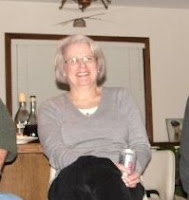Tim
Cuprisin
January
14, 1958-November 23, 2011
Vicnija
Pamjat. Eternal Memory.
Tim Cuprisin, president and founding father of the Lake
Michigan Chapter of the Carpatho-Rusyn Society and creator of its blog, passed away Wednesday, November
23 at home.
At the age of 20, the Chicago native graduated from the
University of Central Michigan in 1978. He started his career as a police
reporter at Chicago’s City News Bureau then moved on to the Green Bay
Press-Gazette and USA Today before going to the Milwaukee Journal in 1986. Included in his assignments were covering the
impact of the fall of the Berlin Wall and communism on six Eastern European
countries. His long-time fascination
with television programs led to a daily TV and radio column in the Milwaukee
Journal (now the Journal Sentinel). In
2009, he took his writing talents to OnMilwaukee.com.
On March 13, 2010, Tim met with 15 people from Northwest
Indiana, the Greater Chicago area and Wisconsin at the Polish Museum in Chicago
to create the Lake Michigan Chapter of the Carpatho-Rusyn Society. With his vast knowledge of his Carpatho-Rusyn
heritage, Tim was unanimously elected president. The first event of the new chapter in June
2010 drew 104 people to hear National C-RS President John Righetti’s talk “Who
are the Rusyns?”. According to Righetti,
it was a record number for a first-time event held by any of its chapters.
In the year and a half since that first public meeting, more
than 300 people have attended at least one event sponsored by the chapter. Those events include hosting the author of The
Linden and the Oak Mark Wansa for the first celebration of Carpatho-Rusyn Day,
newly instituted by the World Council of Rusyns in 2010. Other undertakings of the organization
include a genealogy workshop focusing on Eastern European resources and a
pysanky workshop where attendees learned how to turn eggs in works of art using
wax, a stylus and dye just as their ancestors had done in “The Old
Country”. Conversations at the Rusyn New Year’s potluck
luncheon focused what was or wasn’t on the attendees' Christmas Eve Holy Supper
table now or when they were growing up. Pagach and pirohi were a big hit
and quickly disappeared.
 |
| Tim's last appearance |
Tim’s last public appearance was at the Lake Michigan
Chapter’s Carpatho-Rusyn Day luncheon in October which celebrated 100 plus
years of Rusyns in Northwest Indiana and recognition of the 100
th
anniversaries of St. Michael Byzantine Catholic Church and Protection of the
Virgin Mary Orthodox Church. An avid
collector of all things related to his ethnic background, his presentation
featured early 20
th century photographs of Rusyn immigrant life, the
six churches they founded around the tip of Lake Michigan and a Pepsi Cola ad
with the sales pitch in Rusyn. History
Professor Jim Lane of Indiana University Northwest and the Northwest Indiana
Archives explained what brought the immigrants to northwest Indiana, far from
their arrival ports on the east coast.
Tim’s determination to preserve his ethnic identity and his
access to media resources led him to create the chapter’s blog which features
news about Rusyns here and abroad. The hunger of Carpatho-Rusyns for
information about their heritage and what was happening to other Rusyns brought hits from across the globe. The Lake Michigan Chapter board will continue
the blog.
At the time of his death, Tim was also working on a book
about Andy Warhol, a world-renowned Rusyn artist, as well as a murder mystery
set in Chicago.
Tim is survived by his brothers John, Ken and Dave, a sister
Elaine Black and his partner Sharon Boeldt as well as numerous nieces and
nephews. He was preceded in death by his
parents John and Helen (Cordak) Cuprisin and niece Leslie Cuprisin.
A celebration of his life held Saturday, December 3 brought
about 200 people to the Schmidt and Bartelt Funeral Home in Mequon, Wisconsin. Speakers included his brother Ken, Fr. Thomas
Mueller of St. Cyrill and Methodius Orthodox Church in Milwaukee, friends Jim
Rowan, Andy Tarnoff and Meg Kissinger and his god daughter, Molly Boynton. Carpatho-Rusyn Society Lake Michigan Chapter
members Fr. William Conjelko and Fr. John Lucas closed the memorial with leading
the singing of the traditional Rusyn funeral hymn Vicnija Pamjat/Eternal
Memory.
Donations to a media scholarship in Tim’s name may be
directed to the Hoffman York Foundation, 1000 N. Water St., Suite 1600, Milwaukee, WI, 53202. Donations in his name may also be made to
Mayo Clinic's Melanoma Research Program at
www.mayoclinic.org/development
or mailed to Department of Development, Mayo Clinic, 200 First St. SW,
Rochester, MN 55905.
On January 14, 2012, the Lake Michigan Chapter will pay
tribute to its first president at its annual Rusyn New Year Potluck. Details will be posted on this blog.


 The church remains an active congregation, although it doesn't have a resident priest (during the warmer months, a priest visits from Minneapolis for monthly Sunday liturgies.)
The church remains an active congregation, although it doesn't have a resident priest (during the warmer months, a priest visits from Minneapolis for monthly Sunday liturgies.)








